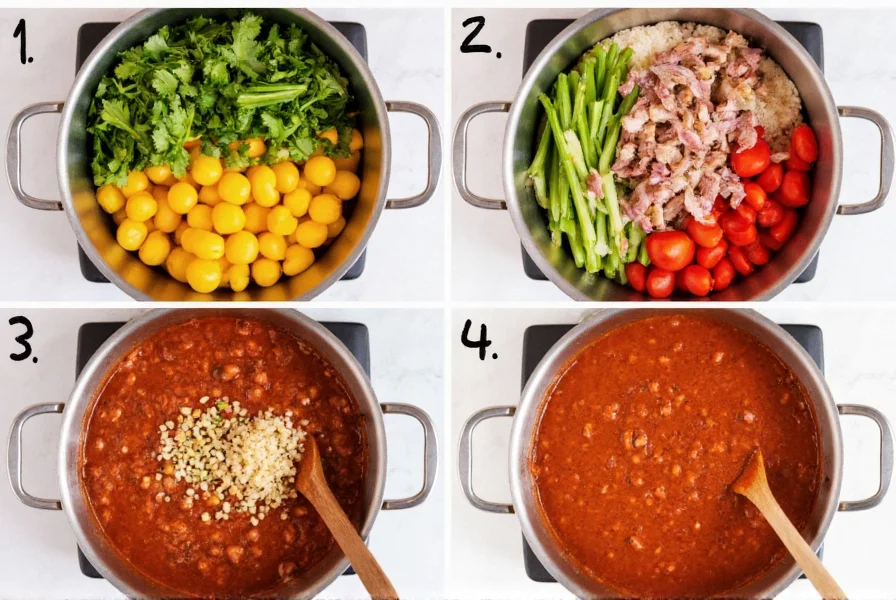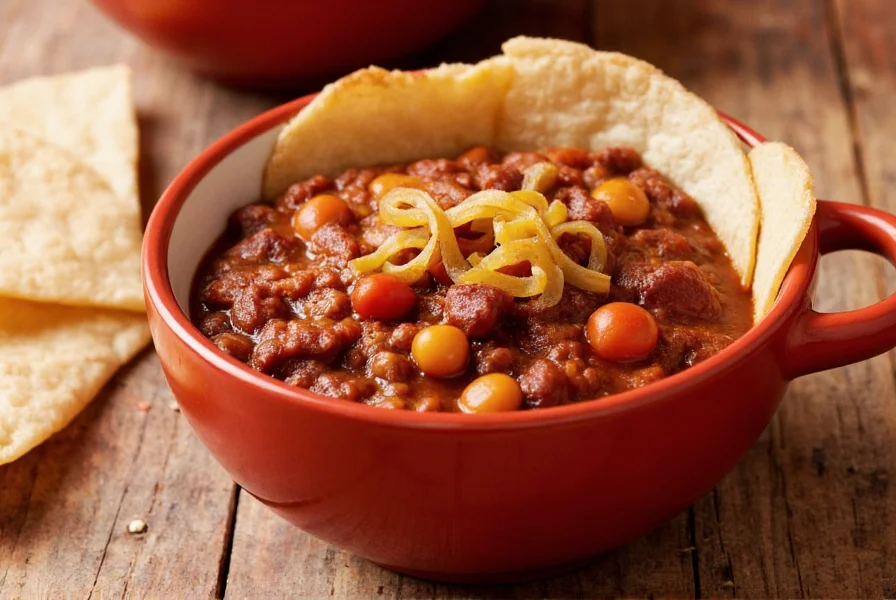When tracking your nutritional intake, understanding the precise calorie content of common comfort foods like chili is essential. This comprehensive guide breaks down the factors that influence how many calories is a bowl of chili, providing accurate information to help you make informed dietary choices.
What Constitutes a Standard Bowl of Chili?
The term "bowl" can be misleading when calculating calories in chili. Restaurant portions often exceed standard serving sizes, while homemade versions vary based on personal preferences. For accurate calorie counting, we need to establish standard measurements:
| Serving Size | Measurement | Common Context |
|---|---|---|
| Standard serving | 1 cup (240ml) | Nutrition labels, diet tracking |
| Restaurant portion | 1.5-2 cups (350-480ml) | Typical dining out experience |
| Hearty meal portion | 2+ cups (480ml+) | Home cooking, comfort meal |
Key Factors That Determine Chili Calories
The calorie count for how many calories is a bowl of chili depends on several critical ingredients and preparation methods. Understanding these variables helps you estimate or control the nutritional content of your meal.
Meat Selection and Preparation
The protein source significantly impacts the total calories in chili. Here's how different meat options affect the calorie count per 1-cup serving:
- Ground beef (80% lean): Adds approximately 280-320 calories
- Ground turkey (93% lean): Contributes about 180-220 calories
- Vegetarian protein (beans, lentils): Provides 150-200 calories
- Extra lean beef (95% lean): Contains roughly 200-240 calories
Draining excess fat after browning meat can reduce calories by 30-50 per serving. This simple step in preparing homemade chili calories makes a noticeable difference in the final nutritional profile.
Beans and Legumes
Beans add fiber and protein but also contribute to the total calorie count. A ½ cup serving of beans typically adds 100-120 calories to your bowl of chili. Common bean varieties include:
- Kidney beans: 105 calories per ½ cup
- Black beans: 110 calories per ½ cup
- Pinto beans: 115 calories per ½ cup
- Lentils: 110 calories per ½ cup
Fats and Oils
The cooking fat used significantly impacts the calorie density of chili. One tablespoon of oil adds approximately 120 calories. Many traditional chili recipes use 1-2 tablespoons of oil for sautéing, contributing 120-240 calories to the entire pot.
Toppings and Garnishes
What you add on top of your chili dramatically affects the final calorie count. Consider these common additions per serving:
- Cheese (¼ cup shredded): +110 calories
- Sour cream (2 tbsp): +50 calories
- Avocado (¼ medium): +80 calories
- Corn chips (small handful): +150 calories
- Green onions (2 tbsp): +5 calories
Nutritional Profile Beyond Calories
When evaluating how many calories is a bowl of chili, it's important to consider the complete nutritional picture. A standard 1-cup serving of traditional beef chili typically contains:
- Protein: 15-20g (supports muscle maintenance)
- Fiber: 8-12g (aids digestion and promotes fullness)
- Fat: 10-15g (varies based on meat fat content)
- Carbohydrates: 25-35g (primarily from beans and vegetables)
- Sodium: 600-900mg (can be reduced with low-sodium ingredients)
This nutrient-dense profile makes chili a relatively balanced meal option compared to many other comfort foods. The combination of protein, fiber, and complex carbohydrates creates a satisfying meal that can support weight management goals when portion-controlled.
Calorie Comparison: Homemade vs. Restaurant vs. Canned
Where you get your chili dramatically affects the calorie count. Understanding these differences helps you make informed choices whether you're meal planning, dining out, or choosing convenience options.
| Chili Type | Calories per 1-cup | Calories per Typical Serving | Notes |
|---|---|---|---|
| Homemade (standard recipe) | 280-320 | 280-320 | Control over ingredients and portions |
| Restaurant serving | 250-300 | 375-600 | Typically 1.5-2 cups with added toppings |
| Canned chili (regular) | 270-330 | 270-330 | Often higher in sodium and preservatives |
| Canned chili (low-sodium) | 180-220 | 180-220 | Reduced sodium but may contain added sugars |
| Vegan chili (homemade) | 200-250 | 200-250 | Higher fiber content, lower saturated fat |
Creating Lower-Calorie Chili Options
If you're monitoring your calorie intake but still want to enjoy this hearty dish, several modifications can reduce the calories in a bowl of chili without sacrificing flavor:
- Use extra lean ground turkey instead of regular ground beef (saves 80-100 calories per serving)
- Increase vegetable content with bell peppers, zucchini, or mushrooms (adds volume with minimal calories)
- Reduce added fats by using cooking spray instead of oil (saves 100+ calories per recipe)
- Boost beans and reduce meat for more fiber and less saturated fat
- Choose low-sodium broth instead of water for added flavor without extra calories

Is Chili Considered a Healthy Meal Option?
When prepared thoughtfully, chili can be an excellent component of a balanced diet. The combination of lean protein, fiber-rich beans, and nutrient-dense vegetables creates a meal that:
- Promotes satiety and helps with portion control
- Provides sustained energy release due to complex carbohydrates
- Contains antioxidants from tomatoes and spices like chili powder
- Can be adapted to accommodate various dietary needs (gluten-free, dairy-free, etc.)
The key to making chili a healthy choice lies in ingredient selection and portion control. By understanding exactly how many calories is a bowl of chili in your specific preparation, you can incorporate this comforting dish into virtually any eating plan.
Practical Tips for Calorie-Conscious Chili Lovers
Whether you're tracking calories for weight management or general health awareness, these practical strategies help you enjoy chili while staying within your nutritional goals:
- Measure your portions - Use a measuring cup until you can accurately estimate 1-cup servings
- Prep in batches - Cook a large pot, divide into single servings, and freeze for convenient healthy meals
- Track ingredients - Use a food scale and nutrition calculator when developing your homemade chili calories profile
- Request modifications when dining out - Ask for smaller portions or hold high-calorie toppings
- Focus on flavor builders - Use spices, vinegar, and citrus instead of fats to enhance taste
Frequently Asked Questions
How many calories are in a bowl of chili at a restaurant?
Restaurant chili portions typically range from 1.5-2 cups, containing 375-600 calories depending on the recipe. Most establishments use higher fat meats and add toppings like cheese and sour cream, which significantly increase the calorie count compared to standard 1-cup servings.
Is vegetarian chili lower in calories than meat chili?
Generally yes. A 1-cup serving of vegetarian chili typically contains 200-250 calories compared to 250-350 for traditional beef chili. The difference comes from replacing higher-calorie meats with beans and vegetables, though the exact count depends on added fats and other ingredients.
How can I reduce calories in homemade chili without losing flavor?
You can reduce calories by using extra lean meats or plant-based proteins, increasing vegetable content, using cooking spray instead of oil, and adding flavor with spices, vinegar, and citrus rather than fats. Draining excess fat from browned meat saves 30-50 calories per serving without compromising taste.
Does the type of beans affect the calorie count in chili?
All common beans used in chili (kidney, black, pinto) have similar calorie counts - approximately 100-120 calories per ½ cup serving. The primary nutritional differences are in fiber content and specific micronutrients, not significant calorie variations between bean types.
How accurate are canned chili nutrition labels?
Canned chili nutrition labels are generally accurate for the product as packaged. However, many people add toppings like cheese or sour cream, which aren't reflected in the label. Additionally, some 'hearty' or 'gourmet' varieties may contain more meat and fats than standard versions, so always check the specific product's nutrition facts.











 浙公网安备
33010002000092号
浙公网安备
33010002000092号 浙B2-20120091-4
浙B2-20120091-4